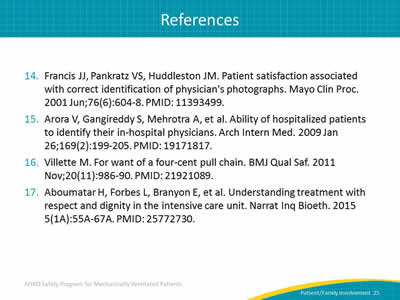Patient and Family Involvement in Care of Mechanically Ventilated Patients: Facilitator Guide
AHRQ Safety Program for Mechanically Ventilated Patients
Slide 1: Patient and Family Involvement in Care of Mechanically Ventilated Patients
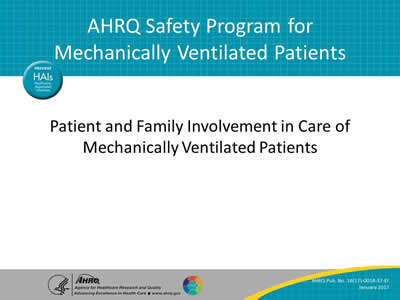
Say:
This module is about patient and family involvement in patient care.
Slide 2: Learning Objectives
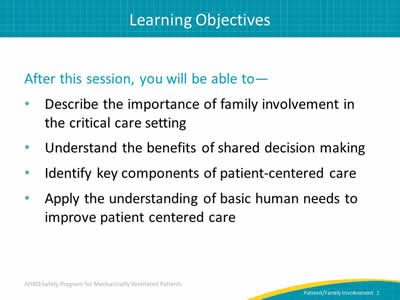
Say:
At the end of this module, you will be able to describe the importance of family involvement in the critical care setting. You will understand the benefits of shared decision making and be able to identify key components of patient-centered care. In addition, you will be able to apply the understanding of basic human needs to improve patient-centered care.
Slide 3: Family Involvement
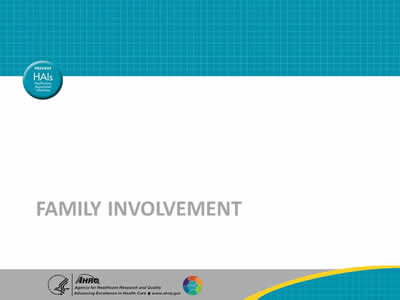
Say:
We will first focus on the importance of integrating the family of the patient into the patient’s care.
Slide 4: Why Are You Doing This?
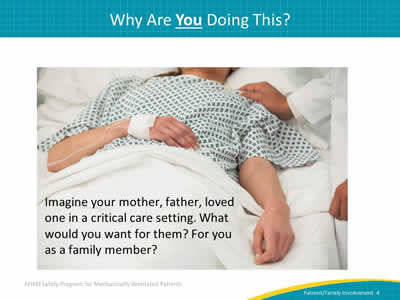
Say:
Imagine if your mother, father, sister, brother, or other loved one was in the intensive care unit in the hospital. How would you feel and what would you want for them? Would you stand by their bed, yearning to do something that would make them feel a little more comfortable? Perhaps you might sit in the corner, reading a newspaper or watching TV, feeling helpless but wishing you could contribute in some way to your family member’s care. Or, you might wander around aimlessly feeling like you were intruding on the care being provided by the health care experts in the room.
Although we may recognize that the family members are the eyes and ears of the patient, having the situational awareness of what is occurring in the room and to the patient, we do not always give family members the opportunity to speak up and be a part of the plan of care. Who are the experts in the room? Typically we think of the trained health care providers. Have you ever thought of the family member as an expert on the patient’s care? The health care provider has only just met the patient, while the family member might have taken care of the patient for a number of years due to a chronic condition.
Slide 5: Family Stress in the Intensive Care Unit
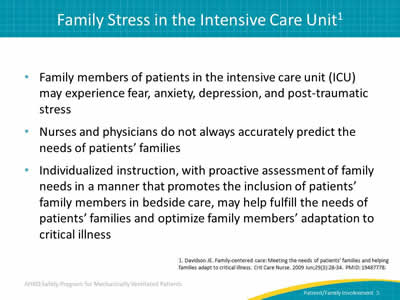
Say:
Family members of patients in the intensive care unit, or ICU, may experience fear, anxiety, depression and post-traumatic stress. If nurses and physicians could accurately predict the needs of patients’ families, some of this stress could be reduced. Consider the current practices you have in place around patient- and family-centered care in your organization. Are family members included in rounds? Do you have open visitation? Are family members encouraged to be present in emergency or code situations and if so, is that constructive and productive to the team? Individualized instruction, with proactive assessment of family needs in a manner that promotes the inclusion of patients’ family members in bedside care, may help fulfill the needs of patients’ families and optimize family members’ adaptation to critical illness.
Including family members in the health care team can improve clinical decision making and has the potential to improve many undesirable outcomes such as preventable harms. Families’ stress can be reduced, and communication is improved. There is a lot of evidence to show the value in including family members as part of the health care team. Unfortunately, providers in hospital settings are so focused on the many tasks that must be completed that they neglect to consider the value of including family members in parts of the patients’ care. They think they do not have time to educate or teach family members how to do some of the simpler tasks of patient care.
Slide 6: What Could Have Improved the Experience?
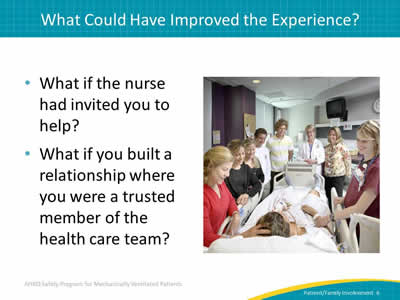
Ask:
When you think about that experience that you imagined or remembered with a family member or loved one in the hospital, what might have helped to make you feel more included?
What if the nurse had invited you to help provide some of the care?
What if you were to build a relationship where you became a trusted member of the health care team?
Say:
Visits by family members are not always limited to 1 day or 1 week, but extend to as long as several weeks or even months while the patient remains in the hospital. These times are opportunities for family members to become trusted members of the health care team because they are allowed and encouraged to take part in care.
Slide 7: Development of Family Involvement Menu
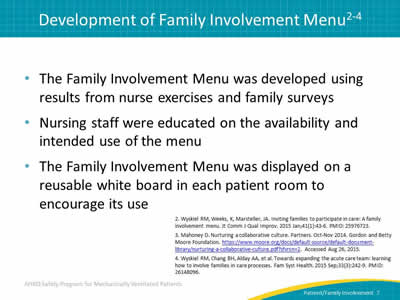
Say:
The Family Involvement Menu is a tool that enables family members to be a part of direct patient care. In this case, it was developed using the results from nurse empathy exercises and family surveys that determined what things the family members wanted to do for the patient, as well as what the health care providers might want assistance with. The nursing staff was educated on the availability and intended use of this menu. To encourage its use and the involvement of family in the patient care process, the Family Involvement Menu was displayed on a reusable white board in each patient’s room.
Slide 8: Family Involvement Menu
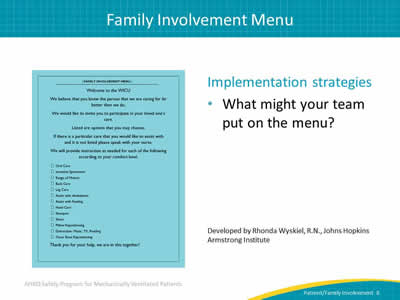
Say:
This menu can be tailored to meet the specific needs of your unit or patient. What daily activities might your team put on your family involvement menu to enable family members to be actively involved in the patient’s plan of care? Whether the family member ensures that oral care takes place on a regular basis, checks to make sure the head of bed has been elevated, or assists with feeding and bathing, partnering with family members in the delivery of care can help to identify and reduce patient risks.
Slide 9: Themes of Family Involvement
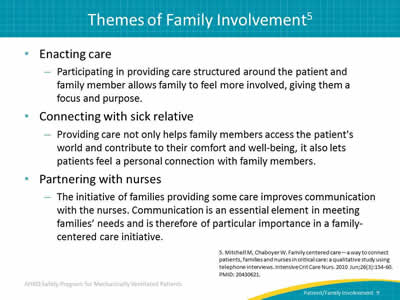
Say:
There are three themes of family involvement. The first is enacting care. Participating in providing care structured around the patient and family member allows family to feel more helpful and involved, providing them with a focus and purpose. The second theme is connecting with the sick relative. Providing care not only gives family members a way to access the patient’s world and contribute to their comfort and well-being, but it also allows patients to feel connected to their family members. The third theme is partnering with nurses. The initiative of having families provide some care might improve communication with the nurses. Communication is an essential element in meeting families’ needs and is therefore of particular importance in a family-centered care initiative.
Slide 10: Shared Decision Making
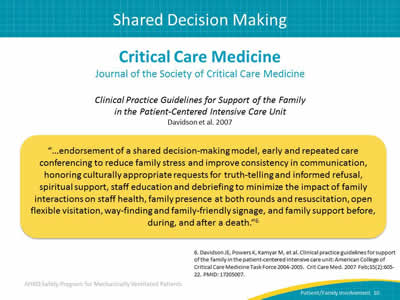
Say:
Research has demonstrated that patient-centered care is associated with better clinical outcomes. Engaging families in patient care can profoundly influence clinical decisionmaking and patient outcomes.
Slide 11: Remember Your Own Experience
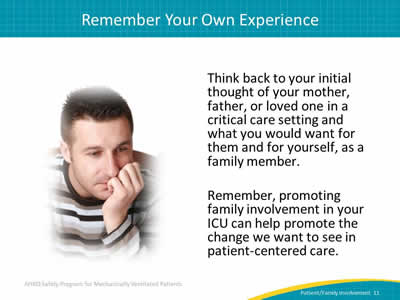
Say:
Put yourself in the shoes of your patient’s family. Consider how you would feel if your loved one was in a critical care setting and what you would want for your loved one and for yourself, as a family member. Be empathetic to their needs and concerns, remembering that the promotion of family involvement in your ICU can hold the key to improving patient-centered care.
Slide 12: Patient-Centered Care
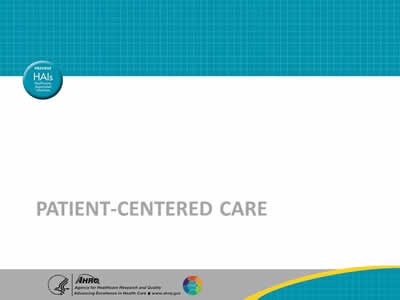
Say:
We will now give an overview of patient-centered care.
Slide 13: Empathy Is Important
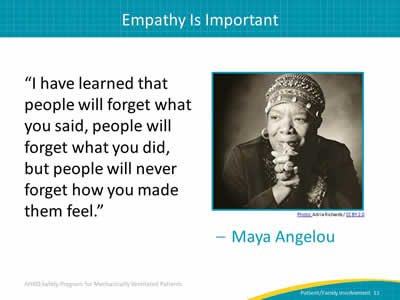
Say:
As health care providers, the ability to empathize and to show patients that we care is extremely important.
As poet, memoirist, and civil rights activist Maya Angelou said, "I have learned that people will forget what you said, people will forget what you did, but people will never forget how you made them feel."
Slide 14: Patient-Centered Care (PCC)
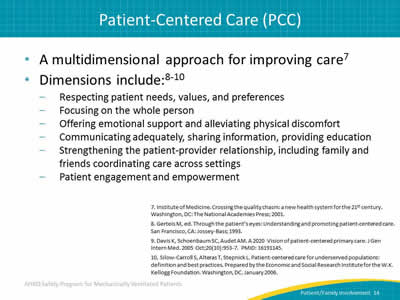
Say:
Patient-centered care (PCC) is a multidimensional approach for improving health care delivery. Early descriptions of PCC included the following dimensions: Respecting patient needs, values, and preferences; focusing on the whole person; offering emotional support and alleviating physical discomfort; communicating adequately, sharing information, and providing education; strengthening the patient-provider relationship, by including family and friends in the coordination of care; and patient engagement and empowerment.
Slide 15: What Do You Have in Place Currently?
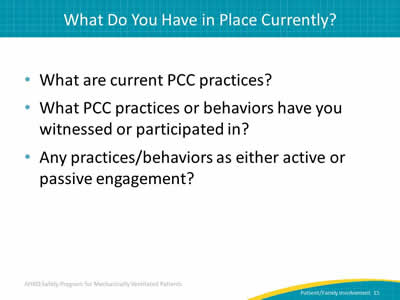
Ask:
What are your current PCC practices or behaviors? Have you seen or participated in any PCC practices you want to adopt on your unit? Are these practices or behaviors passive or active?
Slide 16: Health System–Level Applications for PCC
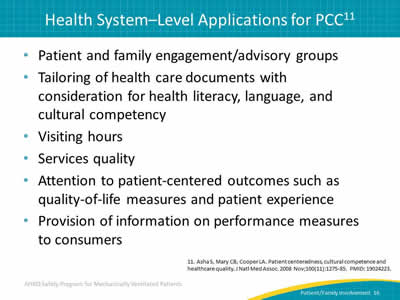
Say:
At a health system level, PCC applications include: establishing patient and family engagement or advisory groups; tailoring all health care documents used in a health system with consideration for health literacy, language, and cultural competency; paying attention to patient centered outcomes such as quality of life measures, patient satisfaction and patient experience; establishing satisfactory visiting hours and services quality; and providing information on performance measures (like the Hospital Consumer Assessment of Healthcare Providers and Systems (HCAHPS) and readmissions data) to consumers.
Slide 17: From the Patient’s Perspective…
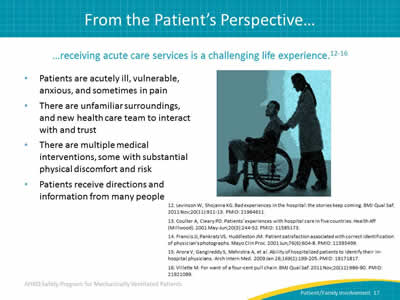
Say:
Being a patient in acute care is a challenging and often traumatic life experience. Patients are acutely ill, vulnerable, anxious, and sometimes in pain. They are in unfamiliar surroundings, being cared for by people they do not know and must learn to trust with their health care needs. There are often multiple medical interventions required with substantial physical discomfort and risk. In addition, it can be overwhelming to receive directions and information from many people. Try to empathize and keep in mind what the patient is going through as you provide care.
Slide 18: Meeting Basic Needs
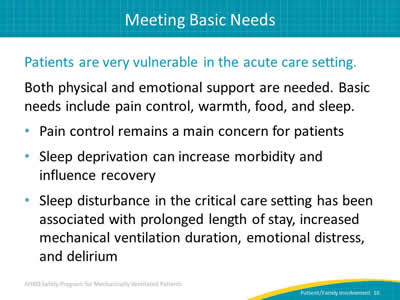
Say:
Patients are very vulnerable in the acute care setting and need both physical and emotional support. Pain control and adequate sleep are two primary concerns. Sleep deprivation can increase morbidity and influence recovery. In fact, sleep disturbance in the critical care setting has been associated with prolonged length of stay, increased mechanical ventilation duration, emotional distress, and delirium. Meeting the patient’s basic needs for pain control, food and sleep will improve patient outcomes.
Slide 19: Respect and Dignity
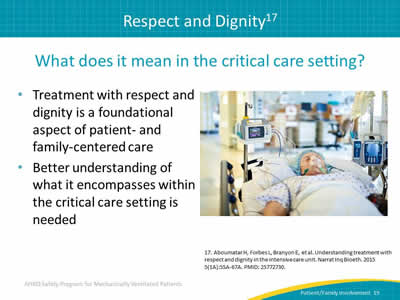
Say:
Respect and dignity is a foundational aspect of healthcare and is central to a positive patient experience. From an ethical standpoint, it is every patient’s right to be treated with respect and dignity.
Ask:
What does respect and dignity truly mean in an acute care setting and what does it mean to you as a health care provider?
Slide 20: Types of Treatment
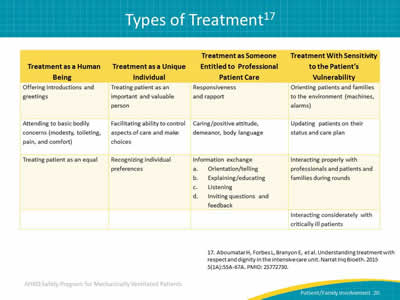
Say:
There are many components to treating patients as unique, valuable individuals entitled to professional patient care. Treating the patient as your equal, while recognizing their individual preferences and needs, requires sensitivity and a caring, positive attitude. Offering introductions and greetings, orienting the patient and families to the environment, and updating patients on their care plan are just some of the important aspects of patient-centered care.
Fostering a culture of patient- and family-centered care will contribute to the improvement of patient outcomes.
Slide 21: Questions?

Ask:
Are there any questions?
Slide 22: References
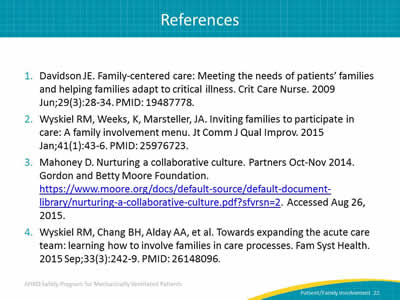
Slide 23: References
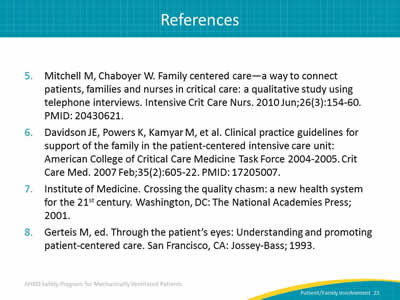
Slide 24: References

Slide 25: References
